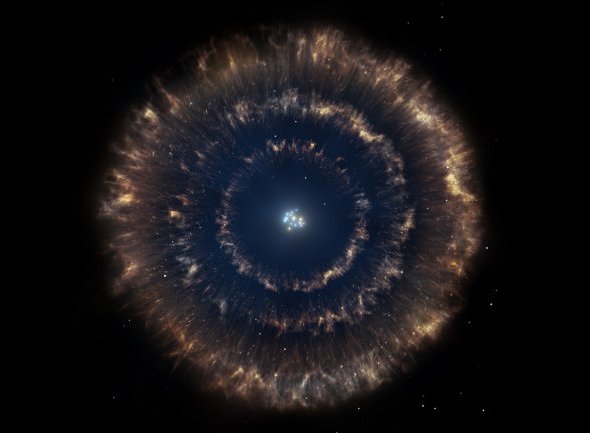Create a free profile to get unlimited access to exclusive videos, sweepstakes, and more!
Astronomers Find Three Exploded Stars Nested Like Russian Dolls

When a star explodes, it’s a catastrophic event on a cosmic scale. The amount of energy released is beyond the grasp of our puny human minds; in a few seconds it blasts out as much energy as the Sun will over its entire lifetime.
Needless to say, you don’t want to be anywhere near a supernova. So what would it be like to be near three of them?
If there are any aliens perusing the skies in the nearby galaxy M33, they got their chance. Astronomers have found the expanding debris from not one, but three previously unknown supernovae. Better yet: The spherical shells of gas hurled outward by these explosions are concentric, centered on the same point in space, which means all three stars were very close to each other when they let go.
This weird triple supernova was found using a technique that specifically looks for rapidly moving gas. It involves a special kind of spectrograph that breaks the incoming light for the sky into very narrow slices of color. The resulting spectrum can reveal a lot of information about an object, including its composition, speed through space, and more.
In this case the spectrograph can create a spectrum for every point in the sky in the telescope’s field of view. For a supernova remnant (the expanding gas from the explosion), some of that gas will be moving toward us (the gas on the near side of the explosion) and some away from us (on the other side of the explosion). The gas heading toward us will have its spectrum shifted toward shorter wavelengths (called blue shift), while the gas moving away will be shifted toward longer ones (red shift).
By mapping these blue and red shifts, the astronomers could see the extent of the expanding gas and how fast the gas is moving. To their surprise, they found the three rings of gas all centered on the same spot, all with different sizes, and moving at different speeds.
They conclude that there must have been a cluster of stars in M33 that had three stars in it of roughly the same age and mass. Judging from how fast the gas is expanding and the size of the rings, the stars blew up 114,000, 40,000, and 21,000 years ago. The bubbles of expanding gas are 140, 52, and 41 light-years across, respectively. Mind you, massive stars live for a few million years, so these three stars blew up pretty close together in time compared to their age. How long a star lives depends on its mass, which is why it seems likely they were born at the same time with the same mass, too.
Each bubble of expanding gas has swept up a lot of material consisting of gas and dust between the stars, adding to its bulk. As I read the paper, I was surprised that the youngest explosion was able to do this. When a star explodes, the gas blasts outward and sweeps up a lot of the material around it like a snowplow. After the first explosion cleaned everything up, I wouldn’t expect there to be enough left for the latest of the three explosions to pick much up.
The astronomers who made the observations expressed the same surprise. They surmise that dense knots of cold gas, which are common in regions of active star formation, were disrupted and boiled off in the first and second explosions, basically evaporating and replenishing the gas swept up. That new material was then plowed up in the subsequent blasts.
Back when I was doing my Ph.D. work, and later on Hubble (as well as when I was writing outreach materials for other NASA missions) I often wondered what it would look like if several supernovae went off near each other around the same time. I wasn’t sure it would ever happen, but these observations look to show exactly this. M33 is less than 3 million light-years away, which is in our back yard as galaxies go; in fact it’s a small spiral that’s part of what we call the Local Group, a loose collection of a few dozen galaxies including ours, the Andromeda Galaxy, and a bunch of dwarf galaxies. That means that this strange matryoshka doll of supernova remnants can be studied in more detail, which is good news.
It also means something else: If we find one in a nearby galaxy, then it’s likely to be a common phenomenon. I hope the search continues and is successful in finding more of these. The Universe is a weird and wonderful place, and a new category of objects is a delight to astronomers … even when they’re the result of some of the most violent events that Universe is capable of.
Tip o’ the neutron star to Michael Krol.


























